If the Chandrayaan’s four-legged craft sticks its landing, it will deploy a 60-pound, solar-powered rover to scour the lunar surface for two weeks. It would also catapult India into a small group of countries, consisting of the United States, Russia and China, that have managed the feat.
While a million people tuned in on YouTube to watch the liftoff from Sriharikota island on India’s southeastern coast, Prime Minister Narendra Modi, who is on an official trip in France, celebrated the successful launch as a “new chapter in India’s space odyssey.”
“It soars high, elevating the dreams and ambitions of every Indian,” he said on Twitter. “This momentous achievement is a testament to our scientists’ relentless dedication. I salute their spirit and ingenuity!”
The $77 million Chandrayaan-3 mission, meaning “moon craft” in Sanskrit, will be India’s second attempt after the Chandrayaan-2, launched in July 2019, crashed on the moon’s surface on Sept. 6, 2019 as a result of what ISRO officials said was a thruster malfunction and software issue during landing.
Despite its decades-long struggle to shed its status as a lower-middle-income country, India has long punched above its weight in space technology, thanks to government support of the space program reaching back to the 1960s. India launched its first rocket in 1963 and put its first homegrown satellite into orbit in 1980. From 2014 to 2022, India had a space probe orbiting Mars until the Mangalyaan orbiter lost contact with ISRO ground stations.
Through it all, India’s space program, a source of national pride, often leaned into its reputation as being ambitious, resourceful — and scrappy. In 1981, ISRO engineers famously showed off its new satellite on a wooden cart, pulled by a white bull. Today, ISRO works with a roughly $1.5 billion annual budget, lagging far behind the $25 billion allocated to NASA and the $12 billion budgeted for the Chinese space agency. But it’s planning to send humans to space in the next two years, becoming only the fourth country to independently do so.
With competition heating up with China, the Biden administration has also proposed deeper space collaboration with India. In January, the White House said NASA would train Indian astronauts at the Johnson Space Center in Houston — marking a break from India’s tradition of training crews in Russia — and promote greater cooperation between U.S. companies and India’s flourishing private space sector. NASA and ISRO are also co-developing an advanced Synthetic Aperture Radar satellite that will be launched on an Indian rocket in early 2024.
The Chandrayaan-3 mission, currently en route to the moon, also carries a NASA-built laser retroreflector array.
NASA Administrator Bill Nelson on Friday congratulated ISRO on the launch and wished it “safe travels to the Moon.”
“We look forward to the scientific results to come from the mission,” he said on Twitter.



